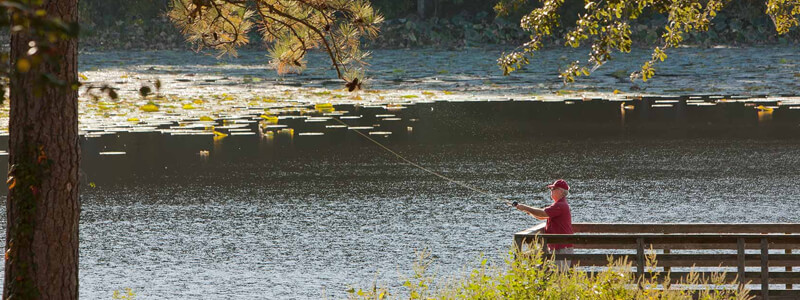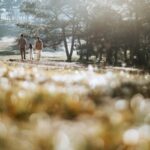Texas is full of natural wonders, many of which can be found in Texas state parks near Houston. The scenery in Texas varies greatly, from the rolling hills of East Texas to the mesquite-lined scenery of Austin to the coastal breeze of Houston.
Whether you are a nature enthusiast or simply need a quick break from the hustle and bustle of city life, Texas has many natural escapes waiting for you.
Here are the best state parks near Houston, all of which are easily accessible on a day trip or weekend getaway.
Huntsville State Park
Contents
Park Road 39, P.O. Box 508, Huntsville TX, 77342
Huntsville State Park lies in the piney woods of the Sam Houston National Forest, near the western edge of the Southern Pine Belt. The heavily-wooded park, dominated by loblolly and shortleaf pines typical of the East Texas Pine Belt, provides attractive camping and picnic areas and encloses the 210-acre Lake Raven. Lake Raven, fed by three major creeks, offers fishing for crappie, perch, catfish, and bass. Hiking trails have been constructed so that wildlife and birds can be observed in a natural setting.
Flora/Fauna
Lake Raven, fed by three major creeks, offers fishing for crappie, perch, catfish, and bass. Hiking trails have been constructed so that wildlife and birds can be observed in a natural setting. White-tailed deer, raccoon, opossum, armadillo, migratory waterfowl, and fox squirrel are just a few of the creatures that may be discovered in their natural environment. Occasionally, alligators may be observed in the lake.
Activities
The park features screened shelters, a screened group picnic pavilion and recreation hall, trailer dump station, restrooms with and without showers, Texas State Park Store, fishing piers, boat rental, boat launching, ramps, hiking, and mountain bike trails.
- Hiking Trails (15.5 miles)
- Boating and Hydrobike rentals
- Nature trail (1.3 miles)
- Biking (mountain and road)
- Camping
- Fishing
- Horseback riding
- Swimming
- Minature Golf
- TEKS-aligned lessons
Galveston Island State Park
Description: Galveston Island State Park features two thousand acres of surf, beach, dunes, coastal prairie, fresh-water ponds, wetlands, and bay shoreline just down Galveston Island from the city of Galveston, inviting quiet contemplation and recreation. The park is a richly diverse preserve, and hundreds of species of wildlife thrive here–spoonbills resting in an oak mott, tree frogs croaking out mating calls, skimmers nesting in the newly terraced wetlands, egrets fishing the ponds, coyotes prowling the nighttime grassland, sandpipers skittering in the surf, pelicans surveying from high above.
Flora/Fauna
Wading and shore birds, mottled and mallard ducks, raccoons, armadillos, and marsh rabbits can be found in the park for observation and photography. Beach or surf fishing for spotted seatrout, sandtrout, redfish, black drum, croaker, and flounder are also available.
Facilities
Facilities include screened shelters; campsites with water and electricity (premium sites are available); campsites with water and electricity in a group trailer area with a pavilion; restrooms with showers; outdoor showers; picnic sites; a fish-cleaning shelter; an interpretive center; a self-guiding nature/interpretive trail; a Texas State Park Store.; 4 miles of multi-use trails for hiking and mountain bike riding; a .25-mile nature/interpretive trail; and a two-lane, concrete boat ramp located at Pirates Cove adjacent to the park.
Activities
- Birdwatching
- Camping
- Canoeing/Kayaking
- Fishing
- Hiking (4 miles)
- Guided nature walks by appointment
- Interpretive center
- Mountain biking
- Unsupervised beach swimming.
Hours of Operation: Open 7 days a week year-round, except for hurricane watch/warnings.
Busy season is March through October, especially weekends. Size: 2,013.1-acres
Brazos Bend State Park
Brazos Bend State Park offers a scenic haven for birdwatchers and wildlife observers. More than 270 species of birds have been sighted here, and the prehistoric-looking American alligator is the park´s most noteworthy resident. Hiking and biking trails meander through the park´s varied terrains, and several lakes offer excellent fishing. For stargazers, the George Observatory is located within the park.
Most of the park is in the Brazos River floodplains, but there are also areas of flat upland coastal prairies. Numerous swales and depressions become freshwater marshes during periods of heavy rain. In addition to the Brazos River, Big Creek meanders diagonally across the park and is associated with sloughs and oxbow lakes. Other lakes have been created by levees.
Flora/Fauna
Brazos Bend State Park features sycamore; cottonwood; black willow; oaks; more than 270 species of birds sighted; 21 species of reptiles and amphibians, including American alligator; and 23 species of mammals, including bobcat, white-tailed deer, raccoon, gray fox, and feral hog.
The George Observatory
The Observatory houses a Challenger Learning Center for Space Science Education, which takes participants on simulated space missions, complete with a mission control center and a spacecraft simulator. There are also three domed telescopes at the George Observatory: the largest is the 36-inch Gueymard Research Telescope, one of the largest telescopes in the nation open to the public on a regular basis. The George Observatory is open for public viewing on Saturday evenings, and is available by reservation on Friday nights for groups of 30 or more.
Activities/Amenities
- 21 miles of biking trails
- 6 different lakes for fishing
- Free guides on interpretive hikes
- Nature center
- Alligator observation
- George Obersvatory
Facilities
The park offers facilities for day visitors and campers. Restrooms with showers, campsites with water and electricity, screened shelters, trailer dump station, dining hall (capacity 150) with kitchen, ceiling fans, BBQ pits, restrooms, nature trails, and two picnic areas with pavilions are available.
Sheldon Lake State Park
15315 Beaumont Highway, Houston TX, 77049
Sheldon Lake State Park & Environmental Learning Center is a 2,800 acre outdoor education and recreation facility located in northeast Harris County. The park is split into two units: Sheldon Lake is accessible from Garrett and Pineland/Fauna roads, and the Environmental Learning Center is accessible from Beaumont Highway.
The Sheldon Lake Unit encompasses 1,200 acres; 800 are permanently inundated and 400 acres are marsh and swampland. Fishing, small boats and canoes, and birdwatching are the main activities. The Environmental Learning Center Unit provides TEKS-aligned educational programming on pond ecology, nature walks focusing on habitats and animal adaptations, catch-and-release fishing (fishing poles provided), renewable energy, native plant gardening, composting, recycling, and hunter education.
Flora/Fauna
The Lake Unit is home to oak, pine, cypress, sycamore, several types of water lilies, deer, raccoon, opossum, rabbit, alligator, and twenty species of waterfowl. Bald eagles, osprey in winter, and Heron and egret rookeries are found in March-June.
Activities/Amenities
- canoeing
- catch and release fishing
- educational programming
- nature walks
- wildlife observation
- TEKS-aligned lessons
Lake Livingston State Park
300 Park Road 65, Livingston TX, 77351
Lake Livingston State Park contains 635.5 acres along Lake Livingston a 84,800-acre reservoir. It’s located near the ghost town of Swartwout, a steamboat landing on the Trinity River in the 1830s and 1850s and the meeting place of Polk County’s first commissioners court before voters selected Livingston as county seat.
Native emergent plants are limited to the upper areas of the reservoir and in the backs of coves and embayments. The floating exotic water hyacinth is found throughout the reservoir. Lake Livingston is a notable white bass fishery. White bass are plentiful and grow to large sizes. The catfish fishery is dominated by blue catfish. Largemouth bass, striped bass, and crappie are less abundant but good catches are possible in areas of the reservoir where habitat is available.
Flora/Fauna
Park vegetation includes pine-oak woodlands, dominated by loblolly pine and water oak. Typical wildlife of the pineywoods includes an occasional white-tailed deer, mallard duck, raccoon, armadillo, swamp rabbit, or squirrel. Popular fish include crappie, perch, catfish, and bass.
Activities
- Camping
- Picnicking
- Swimming pool (Memorial Day to Labor Day)
- Mountain biking
- Nature study
- Fishing
- Boating
- Day use equestrian is now available: Visitors use the horses provided by Lake Livingston stables and are not allowed to bring their own horses.







